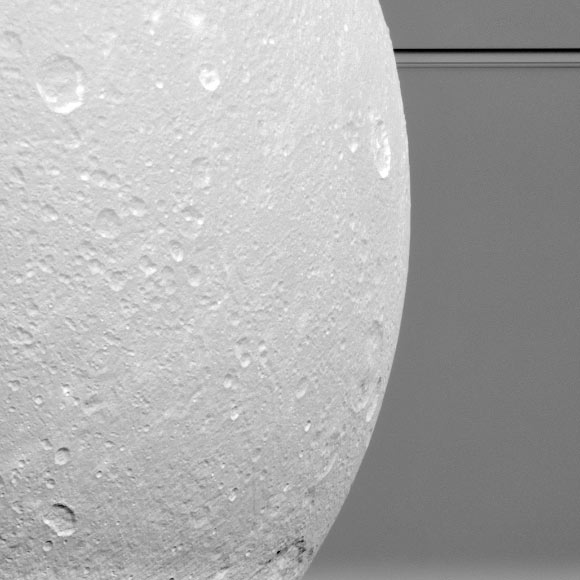This close-up view of Dione was taken by NASA’s Cassini robotic probe during its flyby of this icy moon of Saturn on August 17, 2015.

Dione in front of Saturn’s rings. This view, acquired by NASA’s Cassini spacecraft during a close flyby of the icy moon on August 17, is centered on terrain at 7 degrees south latitude, 122 degrees west longitude. Image credit: NASA / JPL-Caltech / Space Science Institute.
The August 17 flyby is the last close encounter with Dione during Cassini’s mission.
The main goal of this flyby was to use Cassini as a probe to measure the gravity field of Dione, the fourth nearest of the major regular moons of Saturn.
However, scientists also managed to take some stunning images of the moon’s surface.
This image was taken in visible light with Cassini’s narrow-angle camera, which is one of two cameras in the spacecraft Imaging Science Subsystem.
The narrow-angle camera provides high-resolution images of targets of interest, while the second instrument – the wide-angle camera – allows more extended spatial coverage at lower resolution.
“At the heart of each camera is a charged coupled device (CCD) detector consisting of a 1,024 square array of pixels, each 12 microns on a side,” said Dr Carolyn Porco, Cassini Imaging Team leader and director of the Cassini Imaging Central Laboratory for OPerationS (CICLOPS), Space Science Institute.
“The narrow-angle camera packs plenty of power too, and could see a quarter – 0.9 inches (2.4 cm) across – from a distance of nearly 2.5 miles (4 km).”
The view was obtained at a distance of roughly 48,000 miles (77,000 km) from the moon and at a Sun-Dione-spacecraft, or phase angle of 35 degrees.







